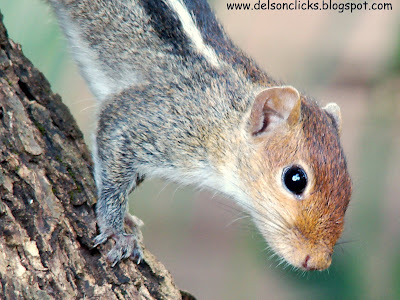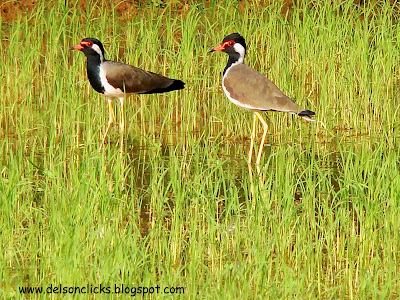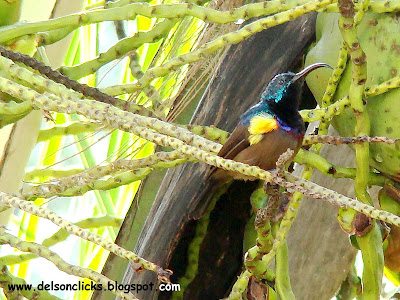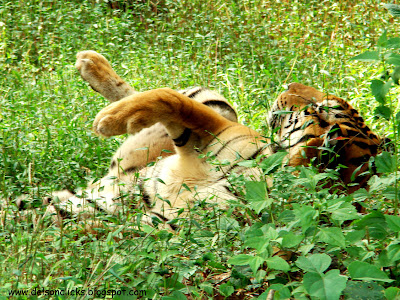 A few days ago, I had posted a series of photographs on Three-Striped Palm Squirrel, well, this time the squirrel had come on the ground, probably was searching for raw materials to build its nest. This time I also observed it had a mate, and probably were planning to start a family.
A few days ago, I had posted a series of photographs on Three-Striped Palm Squirrel, well, this time the squirrel had come on the ground, probably was searching for raw materials to build its nest. This time I also observed it had a mate, and probably were planning to start a family.
Monday, November 12, 2007
Three-Striped Palm Squirrel (Close Up)
 A few days ago, I had posted a series of photographs on Three-Striped Palm Squirrel, well, this time the squirrel had come on the ground, probably was searching for raw materials to build its nest. This time I also observed it had a mate, and probably were planning to start a family.
A few days ago, I had posted a series of photographs on Three-Striped Palm Squirrel, well, this time the squirrel had come on the ground, probably was searching for raw materials to build its nest. This time I also observed it had a mate, and probably were planning to start a family.
Sunday, November 11, 2007
Red-wattled Lapwing


Next time, if you land up in a wetland, and hear the sound 'did-ye-do-it' , then probably this Red-wattled Lapwing is around. This bird can be called the sentry of a forest; since it is uncannily and ceaselessly vigilant, day or night, and is the first to detect intrusions and raise an alarm, and therefore a nuisance to hunters.
Now while photographing birds, one has to approach the bird as close as possible, to get a good shot. Even with a good tele-lens, a close up of the bird is always give a sharp photograph. The following tips may help you in this endeavor.
1. Avoid Black, white or bright coloured clothes, instead wear a dull green colour or a dead leaf coloured dress. Even a violet coloured dress should be fine, since birds are incapable of seeing this colour.
2. Put rubber soled shoes to avoid noise and avoid dead leaves and twigs.
3. Do not make sudden movements, including turning you head suddenly or moving your arms. I keep my one eye glued on to the viewfinder, even if i have put off the camera and look around with the other eye.
4. Keep as small a profile as possible, even going down on knees or hiding partly behind bushes and rocks.
5. Learn from a fox- he hunts alone, so prefer being alone, or if you have company, keep distance from each other.
6. When approaching the bird in open, approach it in zigzag or circular movement, avoid direct forward movement.
7. Early mornings and late afternoons are the best time and windy days are unfavorable for bird photography, since birds are shy and retiring during windy days.
8. I usually photograph on aperture priority, using maximum aperture.
Cattle Egret


 The Cattle Egret, is actually a small white Heron, but unlike other species of heron, which prefer shallow water, this egret prefers dry grassy habitat. I photographed it in a paddy field in mangalore, after the crop was harvested and was probably foraging for insects or grasshoppers. These birds are generally found very close to cattle and other large animals, because, when grazing these animals disturb small creatures which the egrets then catch. This species will be sometimes found riding on the backs of these animals.
The Cattle Egret, is actually a small white Heron, but unlike other species of heron, which prefer shallow water, this egret prefers dry grassy habitat. I photographed it in a paddy field in mangalore, after the crop was harvested and was probably foraging for insects or grasshoppers. These birds are generally found very close to cattle and other large animals, because, when grazing these animals disturb small creatures which the egrets then catch. This species will be sometimes found riding on the backs of these animals.Since I was standing on a paddy field, when photographing the bird , I could not deploy my tripod, on the wet, soggy ground and had to click the photographs holding the camera with my hands. Now in situations like these, where I cannot deploy a tripod and have to use a telephoto lens, I prefer to click the photographs on a burst mode (i.e. you have to click the shutter button once, and photographs are clicked continuously, as long as the shutter button is depressed). The first photograph, where you had to press the shutter button, generally experiences camera shake, (even when on a tripod, the act of pressing the shutter button can sometimes cause slight camera movement, causing blur in photographs) but the subsequent photographs will be much better off. Both the photographs were third pictures of the sequence.
Wednesday, November 7, 2007
Lotens Sunbird



 Early morning today, I was photographing a Lotens Sunbird, feeding on the nectar of coconut flowers. I kept following the bird, through my camera viewfinder, Continuously photographing it. After a while I noticed a sudden change in it's plumage, as apparent in the third photograph. Two bright yellow tufts appeared on either side of its breast out of nowhere. I kept on clicking and soon managed to shoot the fourth photograph. The Upper bird is the Male Sunbird, the one that I was following and the lower one in an acrobatic position is a Female Sunbird. The Reason for the change in the male's plumage was the presence of a female around and he was obviously trying to attract her. Male Sunbirds frequently bring out these beautiful tufts from the underside of their wings, during breeding season and I consider myself lucky to photograph this sequence.
Early morning today, I was photographing a Lotens Sunbird, feeding on the nectar of coconut flowers. I kept following the bird, through my camera viewfinder, Continuously photographing it. After a while I noticed a sudden change in it's plumage, as apparent in the third photograph. Two bright yellow tufts appeared on either side of its breast out of nowhere. I kept on clicking and soon managed to shoot the fourth photograph. The Upper bird is the Male Sunbird, the one that I was following and the lower one in an acrobatic position is a Female Sunbird. The Reason for the change in the male's plumage was the presence of a female around and he was obviously trying to attract her. Male Sunbirds frequently bring out these beautiful tufts from the underside of their wings, during breeding season and I consider myself lucky to photograph this sequence.Sunbirds are very small birds, this one was may be 10 cm in length, they also are swift fliers and rarely perch at one place for long. These factors in addition to the height of the coconut tree made photographing this bird a little difficult. I was shooting on Aperture priority with widest aperture and placed the camera on a short tripod and laying low as inconspicuous as possible.
Since the Underside of a coconut tree is dark, to achieve a faster shutter speed, I clicked the photographs at ISO 200, hence slight noise is visible, when you zoom in the Photograph.
Sunday, November 4, 2007
Duck Tales
Asiatic Lion


Photographs of the critically endangered Asiatic Lion and Lioness. Today they are found only in India and that too only about 350 exist in the Gir Forests. It is believed that by 1907 there were only 13 Asiatic lions left; fortunately the Nawab of Junagadh gave them complete protection and saved them for extinction. Since today all the Asiatic Lion's are descendent's of the 13 lions, many believe that there has been inbreeding within the lions and they could be susceptible to diseases.
The Royal Bengal Tiger

 Yesterday I had read reports that less than 1500 of these magnificent creatures survive in India today and the animal is severely endangered. Today a local daily in Mangalore carried reports of 5 people being arrested with tiger and leopard skins. Saddened by this I decided to make a post on the tiger and dedicate todays post to the Bengal Tiger.
Yesterday I had read reports that less than 1500 of these magnificent creatures survive in India today and the animal is severely endangered. Today a local daily in Mangalore carried reports of 5 people being arrested with tiger and leopard skins. Saddened by this I decided to make a post on the tiger and dedicate todays post to the Bengal Tiger.The tiger is not only a beautiful animal it is also the worlds most favorite animal, In a poll conducted by animal planet in 73 countries the tiger was the favorite animal followed by the dog. Although there are lots of tigers in captivity today, many more than in the wild, the genetic diversity of future generations will tend to be poor and will have a extremely small gene pool. So not only for global warming but for the sake of our favorite animal we need to save our forests.
About the Photograph:
For many on a first glance the first photograph may appear to have been poorly framed, lots of space in the right of the photograph, only three fourth of the tiger being visible and a slight blur or the legs.
The very Idea of this framing is to give the photograph a sense of movement, the empty area in front of the tiger, and the slight blur of the tigers front legs, all help in giving the photograph a sense of motion. The idea being, whatever part of the tiger is out of frame (in this case almost 1/3rd) similar area is left blank in the direction of movement, as if to appear that it will be filled up any moment.
Saturday, November 3, 2007
Leopards Mating

 I was very lucky to be able to photograph these mating Leopards. The tree stump in the foreground did create lots of problem in getting a good angle and clear view to frame the photograph. But then that's nature, which gives wildlife photography its own charm.
I was very lucky to be able to photograph these mating Leopards. The tree stump in the foreground did create lots of problem in getting a good angle and clear view to frame the photograph. But then that's nature, which gives wildlife photography its own charm.Between the sexes, the male leopard is slightly larger and considerably heavier than the female. The average male leopard weighs 63.1 kg, while the average female weighs 37.2 kg.
Like other felines, a female leopard when mating lays flat on the ground on her belly in a position called lordosis, and presents her rear end to the male, which he sniffs to determine if she is receptive. During mating, the male lightly grasps the female on the back of the neck with his teeth. The female responds to this with a low grumble during the entire mating session. The male Leopards penis have tiny backwards facing spines, which are found only in the cat family. They are believed to provide stimulation for ovulation. The act of copulation itself lasts only a minute or two at most, which makes sitings like this all the more rare.
Mugger Crocodile
Saltwater Crocodile



 These Juvenile saltwater Crocodiles are one of the three species of Crocodiles, found in India. The other two being the Gharials and the mugger crocs. The most interesting fact about crocodiles is that the Crocodile embryos do not have sex chromosomes, and unlike humans sex is not determined genetically. Sex is determined by temperature, with males produced at around 31.6 degrees Celsius, and females produced at slightly lower and higher temperatures.
These Juvenile saltwater Crocodiles are one of the three species of Crocodiles, found in India. The other two being the Gharials and the mugger crocs. The most interesting fact about crocodiles is that the Crocodile embryos do not have sex chromosomes, and unlike humans sex is not determined genetically. Sex is determined by temperature, with males produced at around 31.6 degrees Celsius, and females produced at slightly lower and higher temperatures.The second photograph is of the same Croc. but zoomed in to get a clearer photograph of the snout. These Crocs are the largest of all living reptiles.
Photographed at the Pilikula Biological Park- Mangalore
Bonnet Macaque


Look at the head of this monkey, doesn't it look like he is wearing a cap? Well that is why the name Bonnet. This Species of monkey is found in the wild only in India. They carry food in their cheek pouches when foraging.
Living close to human populations these monkeys are so used to humans, that this one was not even looking at me or bothered about me while I was photographing him. Hence I could easily sneak close to him for a good close up shot.
Photograph details: 1/340 sec ; f/4.5
Indian Peacock

 I remember the time, probably 15 years ago, when peacock population was abundant in the outskirts of Mangalore and it was easy to find the feathers strewed around the hills of the city and spotting a bird was easy as spotting a crow. Today in spite of the bird being protected under Schedule I of the wildlife act, the bird sitings have become very rare, mostly because of habitat loss and poaching for meat.
I remember the time, probably 15 years ago, when peacock population was abundant in the outskirts of Mangalore and it was easy to find the feathers strewed around the hills of the city and spotting a bird was easy as spotting a crow. Today in spite of the bird being protected under Schedule I of the wildlife act, the bird sitings have become very rare, mostly because of habitat loss and poaching for meat.Though its meat is tough and not well-suited for consumption, it was prized due to being a luxury and was often served at banquets as a subtlety. This was usually done by skinning the bird, cooking, grinding up and seasoning the flesh, and then redressing it in its own plumage and serving it in a lifelike pose by bracing it with wooden struts. It was also common to discard the meat and stuff the colorful plumage with the meat of other domestic fowl's such as chicken .
I wanted to come closer to the bird to frame it better, but as I approached her, she vanished in the nearby woods.
Photograph details: 1/60 sec , f/4.5
P.S. : I originally thought it was a Peahen- Now I stand corrected , It is a Peacock which has shed its train. Thank you 'Tsinitoboy' for pointing that out. Wish you had given me your contact, I would have personally thanked you for that.
Friday, November 2, 2007
Golden Jackal


This is the only species of Jackal to be found outside Africa. Golden jackals play an important scavanging role by eating garbage and animal carrion around towns and villages. They benefit agriculture by preventing increases in the number of rodents. Golden jackals that are hand-raised can be tamed and kept in houses. They become housebroken and behave much like a domesticated dog, except that they remain shy around strange people and will not allow themselves to be petted by them.
When looked straight on like in the lower photograph, many people can mistake a jackal for a dog. Since It is believed that a Jackals sense of smell is superior than a dog, the chief breeder for Aeroflot airline security, came up with a hybrid between a Siberian Husky and a Golden Jackal and is called the Sulimov Dog.
In the first photograph, a slight camera shake is evident, this inspite of using a tripod. It can happen that the process of pressing the shutter release button may cause a vibration, which becomes apparent especially while using telephoto lens and slow shutter speed. I usually use a 2 sec self-timer when using the camera in telephoto, but here I failed to do it and had to make do with a poor photograph.
Indian Porcupine
An Indian Porcupine ( Hysterix Indica ), with its erect quills.  When In resting position.
When In resting position.
 What happens when you fix quills to a rodent ? It becomes a Porcupine. Porcupines belong to the rodent family and this Indian Porcupine is one of the eleven members of the 'old world Porcupines'. Contrary to popular belief, porcupines are not capable of throwing their quills, but they detach very easily and will remain embedded in an attacker. Porcupine quills are as sharp as needles. When attacked, the Indian porcupine raises its quills and rattles the hollow quills on its tail. If the predator persists past these threats, the porcupine launches a backwards assault, hoping to stab its attacker with its quills.
What happens when you fix quills to a rodent ? It becomes a Porcupine. Porcupines belong to the rodent family and this Indian Porcupine is one of the eleven members of the 'old world Porcupines'. Contrary to popular belief, porcupines are not capable of throwing their quills, but they detach very easily and will remain embedded in an attacker. Porcupine quills are as sharp as needles. When attacked, the Indian porcupine raises its quills and rattles the hollow quills on its tail. If the predator persists past these threats, the porcupine launches a backwards assault, hoping to stab its attacker with its quills.
In India, these are a nuisance to farmers, since they feed on roots of plants. Their meat is considered a delicacy in many countries, the name porcupine itself originates from the French word porc d'épine, meaning thorny pig.
If you find one in your backyard, then probably it has come in search of salt. They can munch on wood, treated with sodium nitrate or certain paints, and tool handles, footwear, clothes and other items that have been coated in salty sweat
I was Photographing the porcupines from a height, the sleeping porcupine spotted me and probably thinking that I was a threat gave me a full display of its quills.
Photograph Details: 1/30 sec , f/4.5
 When In resting position.
When In resting position. What happens when you fix quills to a rodent ? It becomes a Porcupine. Porcupines belong to the rodent family and this Indian Porcupine is one of the eleven members of the 'old world Porcupines'. Contrary to popular belief, porcupines are not capable of throwing their quills, but they detach very easily and will remain embedded in an attacker. Porcupine quills are as sharp as needles. When attacked, the Indian porcupine raises its quills and rattles the hollow quills on its tail. If the predator persists past these threats, the porcupine launches a backwards assault, hoping to stab its attacker with its quills.
What happens when you fix quills to a rodent ? It becomes a Porcupine. Porcupines belong to the rodent family and this Indian Porcupine is one of the eleven members of the 'old world Porcupines'. Contrary to popular belief, porcupines are not capable of throwing their quills, but they detach very easily and will remain embedded in an attacker. Porcupine quills are as sharp as needles. When attacked, the Indian porcupine raises its quills and rattles the hollow quills on its tail. If the predator persists past these threats, the porcupine launches a backwards assault, hoping to stab its attacker with its quills.In India, these are a nuisance to farmers, since they feed on roots of plants. Their meat is considered a delicacy in many countries, the name porcupine itself originates from the French word porc d'épine, meaning thorny pig.
If you find one in your backyard, then probably it has come in search of salt. They can munch on wood, treated with sodium nitrate or certain paints, and tool handles, footwear, clothes and other items that have been coated in salty sweat
I was Photographing the porcupines from a height, the sleeping porcupine spotted me and probably thinking that I was a threat gave me a full display of its quills.
Photograph Details: 1/30 sec , f/4.5
Guppy Fish

Guppy fish were originally native to the Caribbean and to South America , but now they have been introduced in all the continents except Antarctic. Sometimes this has occurred accidentally, but most often as a means of mosquito control, the hope being that the guppies would eat the mosquito larvae slowing down the spread of malaria. This versatile fish can survive both in Fresh water and sea water even in salinity as high as 150% of that of the sea water.
For this photograph, the fish were placed in a transparent polythene bag and behind the bag a black board with a large opening was placed. Light was placed behind the backdrop, the idea being, the silver body of the fish would reflect the light and the black background would provide the contrast for the fish to be visible.
Photograph details: shutter 1/1000 sec , f/2.7 .
Indian Pond Heron

 Photograph of a non-breeding Indian Pond Heron, during breeding season there is a change in its plumage and the bird looks much prettier. Although this bird is generally found near marshes and pond foraging for amphibians or fish, I spotted this one dry land, probably foraging for frogs or toads. Since the colour of this heron blended well with the surroundings, I found it difficult to make the bird standout in this photograph. The bird was so well camouflaged that, its because of its call, I managed to spot it.
Photograph of a non-breeding Indian Pond Heron, during breeding season there is a change in its plumage and the bird looks much prettier. Although this bird is generally found near marshes and pond foraging for amphibians or fish, I spotted this one dry land, probably foraging for frogs or toads. Since the colour of this heron blended well with the surroundings, I found it difficult to make the bird standout in this photograph. The bird was so well camouflaged that, its because of its call, I managed to spot it.Photograph Details: 1/30 sec , f/4.5 , spot metering, WB cloudy.
Subscribe to:
Posts (Atom)




